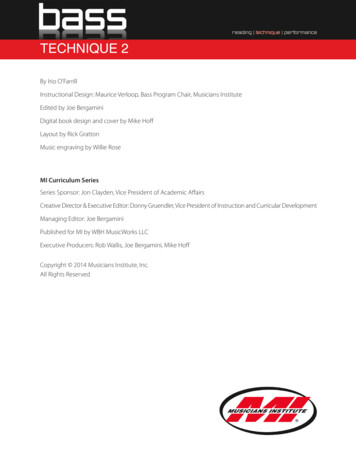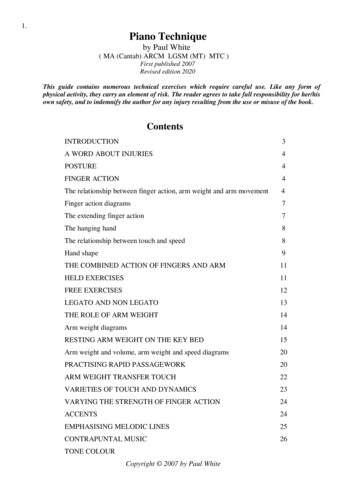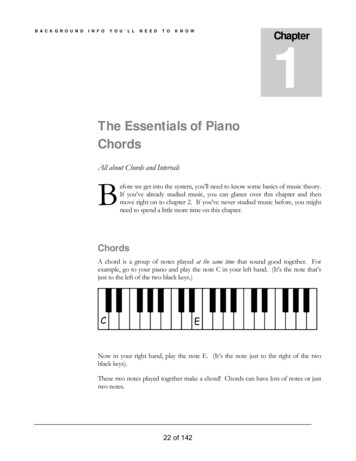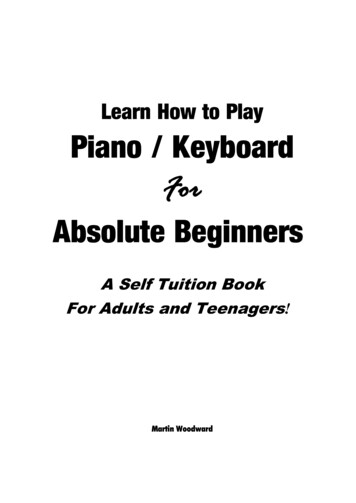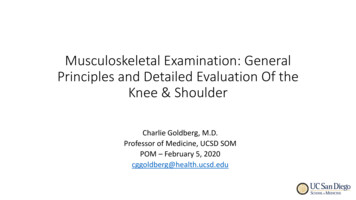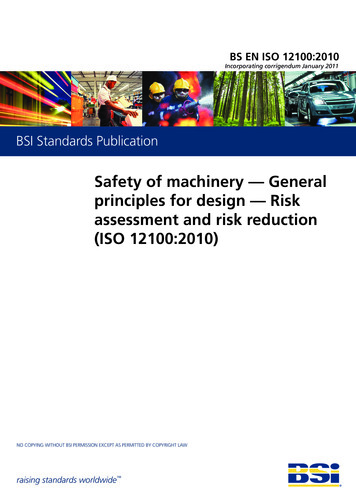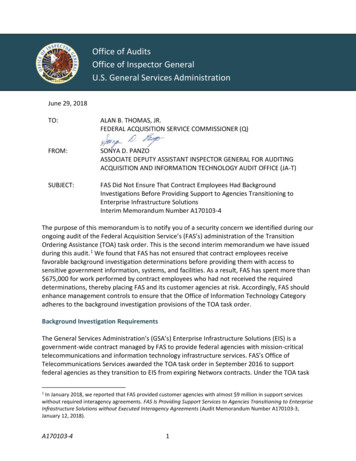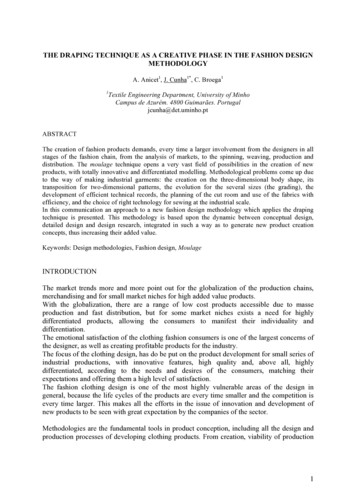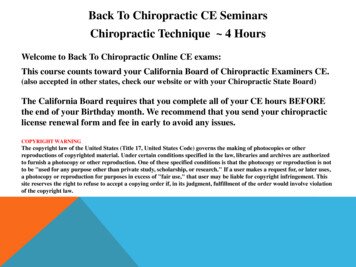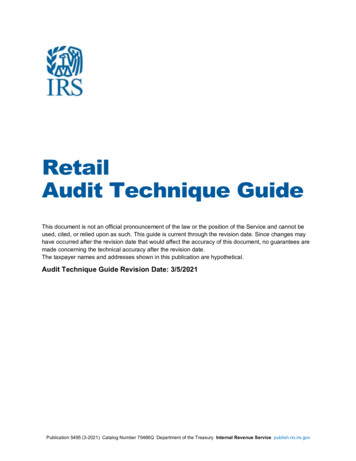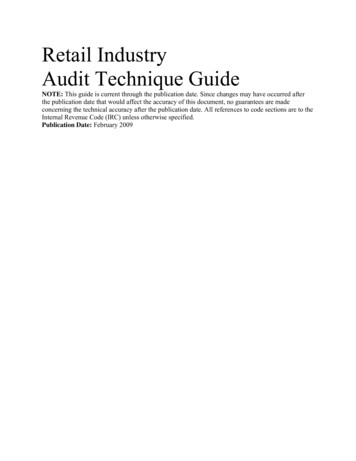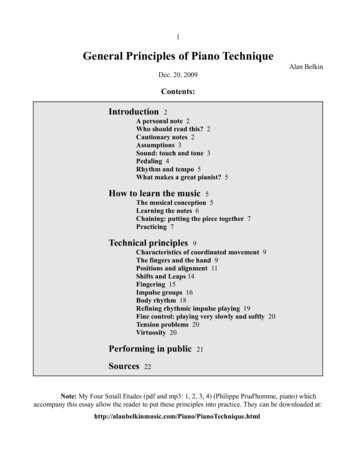
Transcription
1General Principles of Piano TechniqueAlan BelkinDec. 20, 2009Contents:Introduction2A personal note 2Who should read this? 2Cautionary notes 2Assumptions 3Sound: touch and tone 3Pedaling 4Rhythm and tempo 5What makes a great pianist? 5How to learn the music5The musical conception 5Learning the notes 6Chaining: putting the piece together 7Practicing 7Technical principles9Characteristics of coordinated movement 9The fingers and the hand 9Positions and alignment 11Shifts and Leaps 14Fingering 15Impulse groups 16Body rhythm 18Refining rhythmic impulse playing 19Fine control: playing very slowly and softly 20Tension problems 20Virtuosity 20Performing in publicSources2122Note: My Four Small Etudes (pdf and mp3: 1, 2, 3, 4) (Philippe Prud'homme, piano) whichaccompany this essay allow the reader to put these principles into practice. They can be downloaded .html
2IntroductionA personal noteI started my musical life as a pianist and composer. After many years of piano study, I began toplay the organ, and did not play the piano again for many years. Finally I had the means to purchase abeautiful Steinway, and now I have come back to my musical "home". At first I reviewed repertoire Ihad previously played, but I gradually moved towards more difficult works, which I had always wantedto play, but never mastered. This led to an in depth rethinking of my technique; many things evolved orchanged completely. My work on these advanced pieces led me to fascinating discussions with pianistcolleagues and friends, and also to lots of new reading. This essay is the result of these changes. Icannot claim to provide the "right way" to play the piano, but I can say that there is nothing in here Ihave not tried out myself: Everything I say here has at least worked for me. This is thus a personaldocument; as such it is subject to change. I am a good pianist, but not a great virtuoso; therefore mycomments, especially in the section on virtuosity, should be taken with a grain of salt! This essay willbe updated often, so please see the date on the first page.Who should read this?My objective here is to present general principles of piano technique. Although these principlesare fundamental, this essay is not meant for beginners. Piano playing is a very complex mental andmotor skill; a beginner has so much to get accustomed to that he will not be able to appreciate or applyall these points at once. (His teacher, however, must maintain a global view, to prevent him fromforming bad habits.) The pianist who will find this essay most useful is one who is already playingintermediate repertoire, but who wants to move further towards musical and technical virtuosity.Cautionary notes It is not easy to communicate physical movements and coordinations without visual and tactilefeedback. Ideally, the student not only needs to see someone demonstrating what is described,but also to feel the sensations which go along with the discussion (good teachers oftendemonstrate sensations by "playing" on the hand or arm of the student), and also to hear theresults. Eventually, I hope to provide video examples to accompany the text. It is important to distinguish descriptions of how piano playing feels to the pianist, from what apianist is actually doing. Even great pianists' descriptions of what they are doing may be grosslyinaccurate from a scientific point of view. For example, often one reads about aiming for"complete relaxation". As a scientific description, this is nonsense: Complete muscularrelaxation only happens after death! Piano playing requires muscle tone, and even musculareffort. What is being described here is how a good pianist looks and feels: uninhibited, withoutexcess tension. A talent for playing the piano is not the same as a talent for teaching, or even foraccurate observation. Within anthologies of discussions and interviews with great pianists, thedifferences between what they say about technique are at times almost comical. One pianistswears by five hours of scales per day; another says scales are useless. One pianist saystechnique is all about relaxation, another says he stays fit and muscled like an acrobat. And evenamong good teachers, pedagogically useful images may not be scientifically accurate. Keepingthis distinction (scientific description versus felt sensation) in mind helps to see past thisconfusion. Watching great pianists is always interesting, but a lot of what goes on in advanced pianism isalmost invisible, involving coordinations which are extremely subtle and almost impossible toobserve - especially from a distance and when the performer is playing at full speed.
3 Knowing tried and true general principles can help you to improve. But reading is no substitutefor a good teacher who can help to pinpoint problems in a given situation, and thus save muchwasteful trial and error. Many of the sensations described here can only be experienced with a properly regulated piano.Uneven action, poor repetition, inconsistent escapement, etc., will only leave you wondering ifthe problem is you or the piano. If you are serious about becoming a good pianist, spend a fewhundred dollars to get your piano regulated by a good technician; it is an essential investment.AssumptionsI make certain assumptions here about the physical side of piano playing. Although some maydisagree, these assumptions are fairly widely accepted by many fine pianists. Any physically normal person can achieve a fairly high level of technical proficiency, given goodteaching and enough practice. This does not mean that anybody can be a great pianist, but thatthe physical skills required to navigate the keyboard are not so difficult as to exclude mostpeople. Piano playing should never cause physical pain, or do physical damage to the pianist. If it does(and provided there is no pre-existing medical problem) you are doing it wrong! The general principles given here are widely applicable, however the details of which positionsand movements to employ in a given situation will vary according to the individual. People'sbodies differ. Also, there are acceptable variations in many situations. The difficulties in piano playing mainly involve learning fine coordinations, not buildingstrength. Pressing down piano keys is not a strenuous activity. (The "weakness" of the fourthfinger is not really a muscular problem but rather a perfectly normal anatomical situation.) The two most important criteria remain:- Does it sound musically convincing?- Is it physically comfortable?Sound: touch and tone“Piano tone colour thus depends not on a single note, but on the combination andinterrelation of tones”. (Samuel Feinberg)A word is needed here about the issue of tone, the way the piano actually sounds. Apart fromthe quality of the instrument itself (and of the technician!) the pianist directly controls very few aspectsof any single note's sound: when the note starts and stops, how quickly it is hit (velocity), whether or not it is pedaled.That is all! So why does every great pianist have a personal, recognizable sound? What makesfor a "beautiful tone"? The answers depend on the relationships between the notes, successive andsimultaneous. By far the most common weakness in pianists who are technically relatively proficient,but whose sound is unimpressive, is due to unimportant notes in a line receiving undue accents, and toinsufficient distinction between planes of tone, e.g. melody and accompaniment. The timing, relative loudness, and the duration of the successive notes within a phrase, the waysof connecting tones - various degrees of separation or overlap, pedaled and/or fingered,corresponding to the shape and character of the line - create articulate, “singing” line. Playingwhere all notes are equal sound dead and mechanical.
4 The timing, relative loudness, and duration of notes sounding simultaneously create multipleplanes of tone, allowing the pianist to suggest varied musical textures. Some textures requireconsistent planes of tone over a whole phrase, e.g. bringing out a melodic line; others requireadjusting certain notes/chords in relation to other individual notes/chords, e.g. voicing a chordto momentarily bring out a middle voice, playing the top notes of an arpeggio as "resonance" tothe lower ones, etc. As anyone who has listened to a computer program playing a piano pieceknows, chords which are unvoiced - all the notes are played equally - sound brittle and harsh.The pianist thus needs to develop a double sensitivity to sound: musical and physical. Again,this sensitivity is much more about relationships between tones than about individual notes."Singing tone" is an important goal for a pianist. How can this be accomplished? To understandthis, we need to compare the piano and the voice. Singers control a note all through its evolution, notjust at its attack; a piano cannot. Singers must stop regularly to breathe; pianists can go on much longerwithout stopping. These facts have important implications: Long notes on the piano must be played somewhat louder than shorter notes, to give them achance of sustaining. Singers never accidentally accent short notes which follow a long note: The loss of breath makesthis unnatural for them. For a pianist, such accents happen all too easily. The pianist must listenall the way through the long notes, so as to correctly gauge the next note's force. Unintendedaccents, on unimportant notes, will ruin the vocal character of a phrase. No two successive notes are ever alike when sung. Therefore, overly equal playing on the pianonever sounds vocal. Each note's force must be proportional to its place in the phrase.Understanding the musical structure is essential (although this goes beyond the scope of thisessay). The feeling of breathing at phrase points can be simulated on the piano by regularly starting newimpulse groups.PedalingChopin (in some sources, Liszt, or Anton Rubinstein) is reputed to have said that the (right)sustaining pedal is the soul of the piano. The key is to think of this pedal as a resonance control, notjust a sustain switch. Pedaling greatly influences the overall sound of the piano, and will also vary withthe room, the instrument, the musical conception, etc. The sustain pedal is not just an off/on switch,but, on a well regulated instrument, usable in many gradations, to obtain various degrees of legato andresonance. Subtleties of pedaling include: Gauging the loudness of successive notes/chords within one harmony, according to the remainingpedal resonance, sometimes called "playing on the overtones". Using short washes of pedal to suggest subtle background planes of tone, adding depth andrichness to the sound at key moments in a phrase. Using the pedal progressively within a phrase, to create a resonant crescendo. Opening the dampers completely before playing, sometimes to pick up resonance from otherinstruments before starting to play, e.g. in chamber music.For more detailed information on pedaling, in various styles, see the book by Joseph Banowetz,in the bibliography.
5Rhythm and tempoMusical rhythm is intimately related to physical rhythm, which has its origin in repetitivemovements (like walking) and breathing. A good musician must be able to maintain a stable tempo, butthis does not mean playing mechanically. There is a good deal of misconception around this point, so itis worth clarifying. Many great musicians have insisted that tempo must be fluid – e.g. Beethoven’s“elastic beat”, or Chopin’s description of “tempo rubato”. This means that around a basic, stable,pulsation, there will be very slight anticipations and hesitations, according to the musical character andstructure. For both technical and musical reasons, the pianist needs to breathe at cadences, and even atvarious smaller articulations within a phrase. This requires adding very small amounts of time. Thereare also places where even a pianist with a perfect technique will take a little extra time, for examplewhen leaping between two different registers from one phrase to another, or when passing from a veryloud passage to a much softer one. Listening to, say, a computer play such passages without micropauses, makes it clear that they sound worse when played absolutely evenly, not better.N.B. The listener must never notice these micro-rhythmic changes as anything other thanmusical phrasing. If the listener feels that the tempo has changed, you are taking too much time.What makes a great pianist?This essay is meant for people who love the piano and who want to improve their playing.However, it is worth reminding ourselves what makes a truly great pianist, above and beyond "normal"musicality and physical skill. When hearing artists like Michelangeli, Richter, Gilels, Horowitz, (toname only four I have heard in person) and other such masters at their best, what strikes one assurpassing about them is: ease: The technique, however transcendent, is not felt as something distinct from the music; personality: The pianist has an individual, beautiful, sound; simplicity and directness of line: Musical intelligence holds the work together, and communicatesit as a single, unified statement; sensitivity: Every detail is given its rightful place; there is also meaningful variety of detail; richness of texture: Multiple musical planes of tone give a sense of depth; excitement, but always under control; emotional range: Great pianists can convincingly play music of many different styles andcharacters; and finally, the rarest quality of all: The ability to speak, intimately, to individual members of theaudience, no matter how big the hall, no matter how many are present.Learning the musicThe musical conception“The 'what' determines the 'how'”. (The Art of the Piano, Heinrich Neuhaus, p. 12, Frenchedition).Technique is means to an end. Although there is sometimes an acrobatic aspect to piano playing,the
General Principles of Piano Technique Alan Belkin Dec. 20, 2009 Contents: Introduction 2 A personal note 2 Who should read this? 2 Cautionary notes 2 Assumptions 3 Sound: touch and tone 3 Pedaling 4 Rhythm and tempo 5 What makes a great pianist? 5 How to learn the music 5 The musical conception 5 Learning the notes 6 Chaining: putting the piece together 7 Practicing 7 Technical principles 9 .
